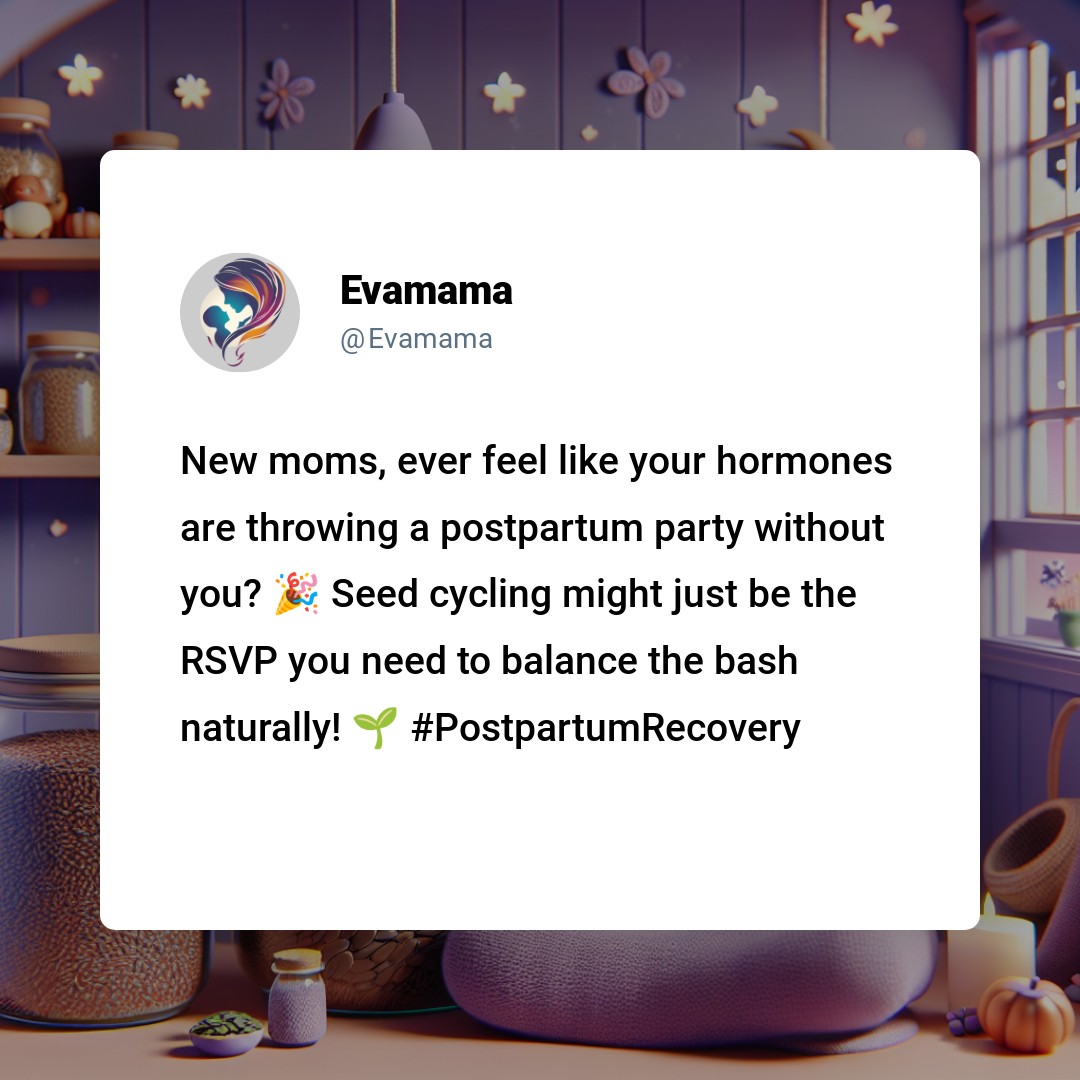Seed Cycling for Postpartum Recovery: A Moms Guide to Hormone Balance
Understanding Seed Cycling and Its Role in Postpartum Recovery
Seed cycling can be a natural path to postpartum hormonal balance. Imagine you’re riding the postpartum emotional rollercoaster, unsure if the next turn will bring a surge of joy or a wave of overwhelm. It’s a journey familiar to many new moms, where the quest for hormonal equilibrium becomes as crucial as a lullaby for a restless baby.
In the delicate dance of postpartum recovery, seed cycling emerges as a gentle partner, whispering promises of harmony to your body’s rhythm. As someone who’s navigated these waters, I’ve seen the subtle power of seeds work its magic.
Let’s embark on this nurturing voyage together, exploring how these tiny kernels of nature can offer big support for your well-being.

Seed cycling is a holistic approach to balancing hormones, particularly after the life-changing event of childbirth. As a new mom, you’re likely navigating the postpartum period, which brings its own set of hormonal shifts. Let’s scrutinize into how incorporating certain seeds into your diet at specific times can support your body’s natural rhythm.
The Menstrual Cycle Post-Birth: A Refresher
After giving birth, your menstrual cycle will eventually resume. It’s a dance of hormones, primarily estrogen and progesterone, which can be out of sync in the postpartum period. Seed cycling aims to harmonize these hormones, potentially easing your transition into motherhood.
Estrogen and Progesterone: Postpartum Recovery Agents
Estrogen and progesterone levels fluctuate after childbirth, affecting everything from mood to milk production. Balancing these hormones is key to a smoother postpartum recovery. Seed cycling could be a natural ally in this process.
The Seed Cycling Method: A Two-Phase Approach
Seed cycling involves rotating flax, pumpkin, sesame, and sunflower seeds into your diet during the two phases of your menstrual cycle. The first phase focuses on seeds rich in phytoestrogens, while the second phase emphasizes seeds with properties that support progesterone production.
Phase 1: Follicular Phase (Day 1-14)
- Flaxseeds and Pumpkin Seeds: These seeds are believed to support estrogen levels, which are important in the first half of your cycle.
Phase 2: Luteal Phase (Day 15-28)
- Sesame Seeds and Sunflower Seeds: These are introduced to encourage healthy progesterone levels in the latter half of your cycle.
Nutritional Powerhouses: The Seeds’ Profiles
Each seed in the cycling process is a nutritional powerhouse. Flaxseeds, for example, are rich in omega-3 fatty acids, which are necessary for inflammation reduction and Health. Pumpkin seeds boast magnesium, beneficial for sleep and stress management—two critical aspects of postpartum care.
Real Moms, Real Results: Anecdotal Evidence
Many new moms report feeling more balanced and experiencing fewer hormonal fluctuations when practicing seed cycling. While scientific research is still catching up, the anecdotal evidence is compelling.
How to Incorporate Seed Cycling Into Your Diet
Incorporating seed cycling into your diet can be as simple as sprinkling ground seeds on your morning oatmeal or blending them into a smoothie. Consistency is key, so finding easy ways to include these seeds in your daily routine will help you stick with it.
Potential Benefits Beyond Hormones
Beyond hormonal balance, seed cycling may offer additional benefits such as improved skin health, better digestion, and enhanced hair growth—areas often affected by postpartum changes.
Seed Cycling: A Natural Approach to Postpartum Wellness
While seed cycling is not a cure-all, it’s a natural approach to consider for postpartum recovery. It’s about supporting your body’s needs during a time of significant change and doing so with the help of nature’s bounty.
Harnessing the Power of Seed Cycling for Postpartum Hormone Balance

Embrace the Seed Cycling Journey: A Step-by-Step Guide for New Moms
You’ve probably heard whispers of seed cycling in your mom groups or read about it online. It’s a natural approach to balancing hormones, especially beneficial during the postpartum period. Let’s dive into how you can integrate this practice into your daily routine.
Follicular Phase: Unleashing the Potential of Flax and Pumpkin Seeds
The follicular phase starts on the first day of your period and lasts until ovulation. During this time, your body benefits from flaxseeds and pumpkin seeds. Flaxseeds are rich in lignans and phytoestrogens, which can help balance estrogen levels. Pumpkin seeds, packed with zinc, support progesterone production as you approach ovulation.
Serving Suggestion: Aim for 1 tablespoon of ground flaxseeds and 1 tablespoon of pumpkin seeds daily. Sprinkle them on your morning oatmeal or blend them into a smoothie.
Luteal Phase: The Magic of Sesame and Sunflower Seeds
Post-ovulation, your body enters the luteal phase. This is when sesame seeds and sunflower seeds come into play. Sesame seeds contain lignans that help block excess estrogen, while sunflower seeds provide a dose of vitamin E, required for progesterone production.
Serving Suggestion: Incorporate 1 tablespoon of each, ground sesame and sunflower seeds, into your diet. They’re great as a yogurt topping or mixed into homemade energy bites.
Consistency is Key: Tracking Your Seed Cycling Progress
To truly reap the benefits of seed cycling, consistency is required. Use a journal or an app to track your menstrual cycle and seed intake. Note any changes in your postpartum symptoms, such as mood swings or sleep patterns, to gauge the effectiveness of seed cycling for you.
Addressing Common Concerns: Irregular Periods and Breastfeeding
If your periods are irregular, start seed cycling on the moon’s cycle, using the new moon as day one of your follicular phase. For breastfeeding moms, seed cycling is considered safe, but it’s always best to consult with your healthcare provider before starting any new dietary regimen.
Seed Preparation: Unlocking Nutritional Benefits
To maximize the benefits, seeds should be ground. This makes the nutrients more bioavailable. A coffee grinder works well, or you can purchase pre-ground seeds. Store them in the refrigerator to maintain freshness.
Incorporating Seeds into Meals: Creative and Delicious Ideas
Seeds can be seamlessly added to various dishes. Here are some quick ideas:
- Mix into salad dressings or sauces
- Stir into soups or stews for a nutrient boost
- Use as a crust for baked chicken or fish
The Role of Seed Cycling in Hormonal Harmony
Seed cycling can be a gentle and natural way to support your body’s hormonal balance postpartum. By aligning your seed intake with your menstrual cycle, you’re working with your body’s natural rhythms, promoting Besides well-being.
Final Thoughts on Seed Cycling for New Moms







